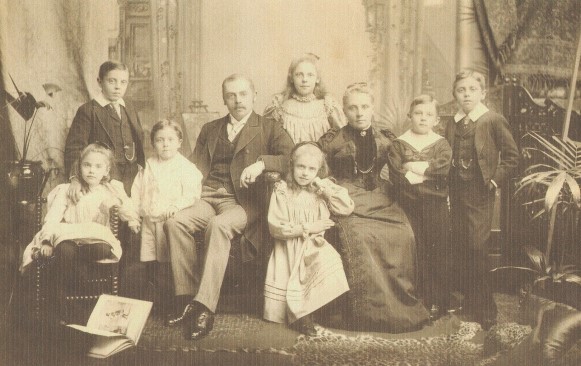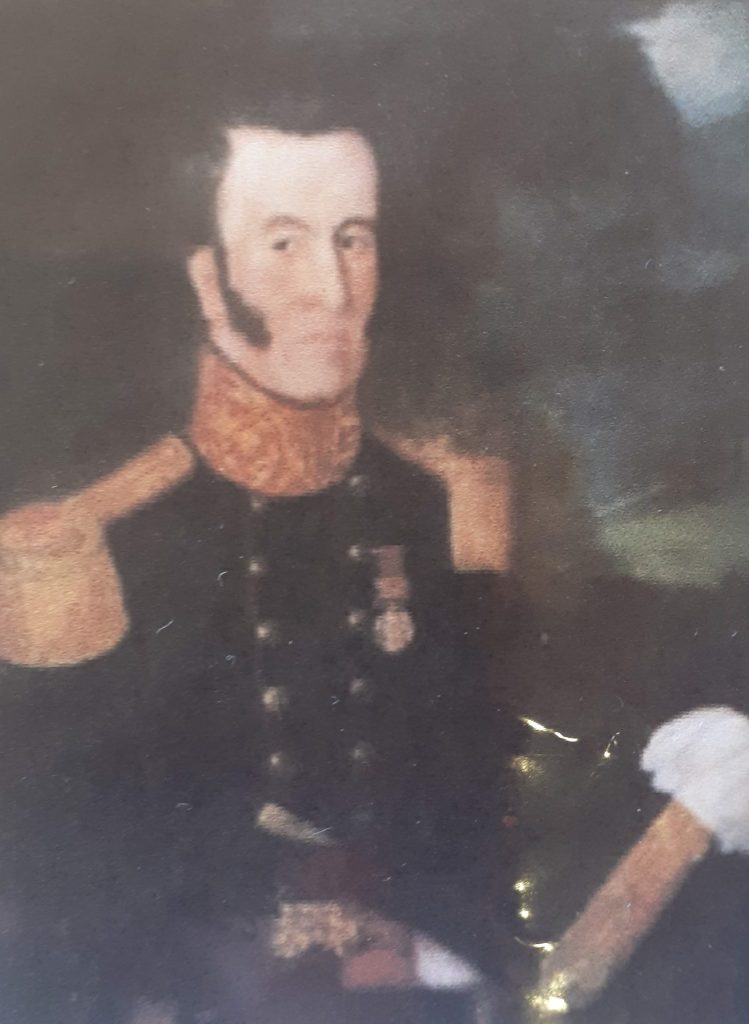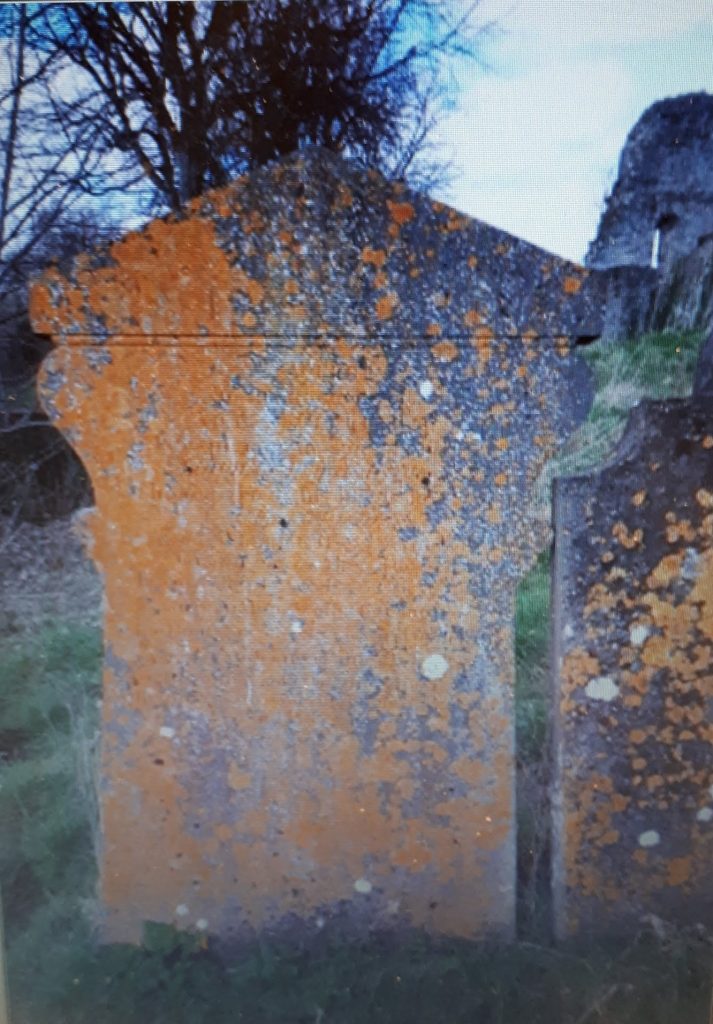My paternal grandmother, Dorothea Emilie Constance Young married my grandfather Percy Bradley 14th April 1904 at St Paul`s Church, Hooton, Chester. Her parents were Col. (Dr.) Thomas Frederic Young and Mary Ellen Baker. Dorothea was one of 7 children, all born in Bootle, Lancs.

The picture above shows a wonderful family portrait of Dr Young, his wife Mary Ellen and their children. With no names given, I think it could be Muriel kneeling between her parents, Mary Gwendoline sitting and Dora (my grandmother) standing between her parents. The boys I think could be Frederick William Baker and the youngest James Osman next to their father, and then Thomas Lowbridge next to his mother and Alfred Henry Innes next to him on the end.
This picture above shows the Bradley children on the ladder with George at the top and then Ray, Osman, Howard, Nora and Dick. I think it may have been taken after Dora had died – 1918/19.
The first clue I had to Col (Dr) Thomas Frederic Young and his family was from the 1871 census at 47 Plumpton St. Everton, Liverpool (age 21) living with his parents Thomas and Elizabeth Young (nee Perkin), and also his sister Anna M. age 23, and brother Alfred N. age 17. Thomas senior was at that time a Master Printer employing 3 men and 2 boys. All this family were born in Ireland with the exception of Elizabeth Young who, on most census returns claims to be a British Subject born in France in 1820. Thomas senior is later known to be a Wine Merchant – this from Directories and the marriage certificate for Rosa Cecilia. In 1881 they are at Derby Road, Bootle and Elizabeth is a widow with Anna Margaret 33 and Nearson (?) Alfred 26 General Practitioner. Also Alfred Nearson Young a surgeon on the MV Olympus! 1891 it is Elizabeth and Anna Margaret at 55 Trinity Road, Bootle.
The question is when did the family move from Ireland to Liverpool? The earliest record is the marriage in 1867 of Rosa to Edwin Lovegrove, but did she come over first and the family followed?
The children of Thomas and Elizabeth were:
Frederick Osman b. 15th February 1845 d. May 12 1848 buried in Esker, Dublin
Anna Margaret b. 28 October 1846 (Dora`s birthday book confirms) d. May 16 1918 Victoria B.C. Canada. Anna Margaret ran a school in Somenos, which later became well known internationally, with the help of a Miss Geoghagen, daughter of Charles Geoghegan an Irish Naval Military Officer. He passed away in 1929. Col. Young is buried about 40 feet away from him in the cemetery at Somenos, Victoria, B.C.
Rosa Cecilia b. 20th March 1848 – d. 12 January 1941. Married Edwin Lovegrove, a Divinity Student from Wilford, Notts. on 8th August 1867. Her residence at that time was Everton, Liverpool and her father Thomas, is listed as a Wine Merchant. The witnesses were Thomas Young and Anna Margaret Young. In 1871 Edwin and Rosa are living in Duke Street, Liverpool with their first born son age 2 and Edwin is Curate of St Michaels. After the death of her husband Edwin in 1880 Rosa became a school teacher and ran her own school in Brooke Road. Sir Adrian Boult was a pupil at this school. She acted as Guardian to a few children at Merchant Taylors`, Crosby, Liverpool, her own 3 sons attending there. In 1881 at 28 Brooke Road, Crosby, Rosa Lovegrove (widow) is living with her three sons.
Thomas Frederic b. 21 April 1850 Dublin d. 1943 Victoria, B.C.
Alfred (Naasoon) b. 22nd March 1853 Dublin ( ‘Uncle Alf’ in Grandmother Dora’s birthday book). In the 1881 census he is listed as ‘Nearson’ Alfred Young living with his mother Elizabeth and his sister Anna Margaret at 264 Derby Road, Bootle. I presume the enumerator misunderstood the name ‘Naasoon’. Alfred Naasoon Young, is a witness at the wedding of his brother Thomas in 1878, along with his other sister Anna Margaret Young. The following is from the memorial stone in the Forest Hills Cemetery, Suffolk Co. Mass. USA which is in memory of officers and men who have died in the service of the Cunard Line.
Dr Alfred Naasson Young
Birth: 1855 England
Death: 9 Jun 1882 (aged 26–27) Boston, Suffolk County, Massachusetts, USA
Burial: Forest Hills Cemetery and Crematory, Jamaica Plain, Suffolk County, Massachusetts, USA
Memorial #: 153068320
Bio: Aged 27 years 13 days
Created by: Margo Reasner (48205047)
Added: 30 Sep 2015
URL: https://www.findagrave.com/memorial/153068320/alfred-naasson-young
Citation: Find a Grave, database and images (https://www.findagrave.com : accessed 20 November 2020), memorial page for Dr Alfred Naasson Young (1855–9 Jun 1882), Find a Grave Memorial no. 153068320, citing Forest Hills Cemetery and Crematory, Jamaica Plain, Suffolk County, Massachusetts, USA ; Maintained by Margo Reasner (contributor 48205047) .
Arthur Wellesley b. 1855 Dublin d. 1855 Dublin
Births for Rosa Cecilia and Arthur Wellesley are not confirmed in the Irish records (Island Bridge, St James) as are the others. The name Naasoon (with various spellings) is also a mystery, only being on Alfred`s gravestone and also at his brother`s wedding. Also the census returns for 1871 and 1881 with the family. There is a death for a Myles Young in 1850 in St James.
Returning to Dublin for a minute, tentative research has not brought too much to light except for the marriage of Thomas Young to Elizabeth Perkin (marriage licence bond) in 1839. There are a few Thomas Youngs listed in directories but it is difficult to say which is the right one. Irish records are notoriously difficult to find as most have been destroyed over the years. A gravestone inscription has been found for the following which I am confident is the father of Elizabeth Perkin.
PERKIN – Sacred to the memory of William Perkin, Esq., late Quarter Master of the First Battalion Royal Artillery, who departed this life June 5th 1852 aged 64 years. Also Frederick Osman Young, grandson to the above, who died May 12th 1848 aged 3 years. And Arthur Wellesley Young who died Nov 24th 1855 aged 5 months, grandson of the above. Also Rosanna, Relict of the above William Perkin, who died Nov. 10th 1860 aged 76 years. A gravestone inscription. See below for full details.
There is a marriage entry in the records (IGI) for Kingston Upon Thames that on the 23rd day of August 1814 William Perkins Bachelor and Rosanna Osmin were married. There is a marriage obligation dated 22nd August 1914 stating the intended marriage between William Perkin and Rosanna of the parish of Alton, Hampshire. Then the following day an entry in the parish records for All Saints, Kingston Upon Thames for the marriage by licence for William and Rosanna. This includes ‘the mark of Rosanna Osmin’. Witnesses Palmer and Maria Porter.
William (63)and Rosanna (66) Perkin appear in the 1851 census living in Woolwich, Greenwich. William is Quarter Master Artillery, born in Congleton Cheshire, and Rosanna in Kingston, Hampshire. There is a baptism for a Rosanna Osman 20th June 1784 Kinson St Clement, Dorset (?)and her parents were Thomas and Elizabeth Osman. There was also a younger sister Ann baptised 1786. Is this one and the same Rosanna? Did William and Rosanna return to Dublin to be buried with their grandson Frederick Osman who had died in 1848, William in 1852. Bear in mind William and Rosanna were in Woolwich in 1851. Also another question arises – were Frederick Osman and Arthur Wellesley actually brothers?
This photo and information very kindly given to me by Fred Lovegrove. William is wearing his Quartermaster`s uniform, wearing his Peninsular war medal which shows that he was with Wellington in Vittoria, San Sebastian, Nive and Nivelle. There is an image of cannon in the background indicating his artillery regiment. A regimental order at the time of his promotion to Quarter-master (13/10/1841) by Col. J Webber Smith CB indicates that he had been in the army for 37 years by that date. This confirms his age of enlisting as 16 years.
Below is an article researched and written by Stephen Callaghan for the Lucan Newsletter June 2018.
| Burial grounds are places of great interest, a connection between the past and present. By doing some research we can connect names on memorials to important or interesting historical events. As such they are often interesting places to visit. It was on one visit to old St Finian’s graveyard that a memorial jumped out at me, the skillfully carved inscription bore the words ‘quarter master’, this grave obviously belonging to a soldier. With further careful reading of the inscription it was clear that the grave belonged to William Perkin, who died in 1852, a time when Ireland was just coming out of the Great Famine. Also interred in the same grave are two grandchildren and his wife. With some follow up research it was possibly to uncover William’s interesting military career which brought him across the globe during the turbulent Napoleonic Wars, this is his story. William was born in Congleton, Cheshire on 16 March 1788. The son of William and Sarah Perkin. He was baptised in the parish of St Peter on 11 April. Congleton was a small town where textile production was an important local industry. William joined the Royal Artillery in 1804, aged 16 years, and given the rank of Driver. The rank was equivalent to that of a private in the infantry. At the time artillery pieces were drawn by horses and the Driver’s job was to help steer the teams of horses which pulled the guns. During his career William moved his way up the ranks to Corporal, then Sergeant, then Quartermaster Sergeant and finally promoted to Quartermaster, which was a commissioned rank. At a time when people might not have travelled much further than outside their own villages, William certainly travelled more than most, likely part due to the ongoing Napoleonic Wars (1803-1815). William’s first posting was to Italy in 1805 and later part of the occupying force in Sicily in 1806 and 1807. This followed with participation in the Battle of Maida (4 July 1806). During the Peninsular War William fought in the Battles of Vittoria (21 June 1813), San Sebastian (7 July-8 September 1813), Nivelle (10 November 1813) and Nive (9-13 December 1813). During the campaign artillery would have been used to great effect against infantry on open ground and during sieges. Before moving to his next theatre of war William married Rosanna Osmin in Kingston, Surrey on 23 August 1814, Rosanna was a native of Hampshire. Having fought through Europe Perkin was sent to the Americas to take part in the War of 1812 (1812-1815), which is a lesser known theatre of the Napoleonic Wars. The war saw Britain and her allies fight against the United States and her allies. Perkin was present during the attack on New Orleans (8-18 January 1815), which was defended by later president Andrew Jackson. Later William took part in the siege and capture of Fort Bowyer (7-12 February 1815). This minor war ended in a stalemate and the signing of the Treaty of Ghent, a peace treaty. William later returned to Europe to be part of the occupation force in Paris under the Duke of Wellington in July 1815. Quartermaster Perkin was promoted to Quartermaster of the 1st Battalion of the Royal Artillery on 1 October 1841. At the time his commanding officer wrote of him (appearing in the Evening Times on 20 October 1841): ‘Artillery office, Dublin Oct. 13, 1841 The Colonel commanding cannot allow Quartermaster Perkin to quit this command on his promotion to Quarter-master of the 1st battalion of Royal Artillery without ex-pressing the high sense of entertains of his valuable services in the field (in the Peninsular) under his immediate command, as well as during a period of nine years as Quartermaster-Sergeant to that part of the regiment quartered in Ireland; and the Colonel feeling assured that Quartermaster Perkin carries with him the respect of all offices under whose orders he has acted wished him every prosperity, and hope his exemplary character as a soldier (which has obtained or him the honour he now holds) for a long period of 37 years (34 of which as a non-commissioned officer), will have the effect of stimulating others to follow his meritorious example. It is requested that this order may be inserted in the Order-books, and read to each troop company of detachments in this command. By order EDWARD TREVOR, Captain R.A. Acting Assistant-Adjutant-General’ Quartermaster Perkin finally retired from the army on 31 March 1852 with a well-deserved pension, having served over 48 years. He later died on 5 June at Airmount, Kilmainham, and was buried in Lucan (Esker Old – gravestone surrounds old parish church of Esker – 2k SE of Lucan). He was likely buried here as his son in law’s family were buried here. The inscription on his headstone reads: SACRED to the memory of WILLIAM PERKIN Esqr late quarter master of the 1st Battalion Royal Artillery who departed this life June 5th 1852 Also FREDERICK OSMAN YOUNG Grand son to the above who died May 12th 1848 Aged 2 years and Arthur Wellesley Young who died Nov.r 24.th 1855 aged 5 Months Grandson of the above Also Rosanna relict of the above William Perkin who died Novr:10th 1860 Thank you to Stephen Callaghan for sharing this very interesting article with us. |
|
Also, myself and other Young researchers are trying to establish a connection that these Youngs in the inscription listed below are the same family. Please see the outline descendant tree for (generation 3) Thomas Frederic Young.
YOUNG – Erected by Mr Myles Young of Lucan in memory of his brother, Thomas Young, who died 15th July 1818 aged 56 years. Also, his father,……Young, who died Dec 1824 aged (7?)8 years. Miles (sic) Young died July 16th 1828 aged 57 years. Anne Young relict died …25th… 1835 aged 64 years. (gravestone in poor condition).
There are vague references to Naason Young, Spamount, Lucan in connection with land holdings.





